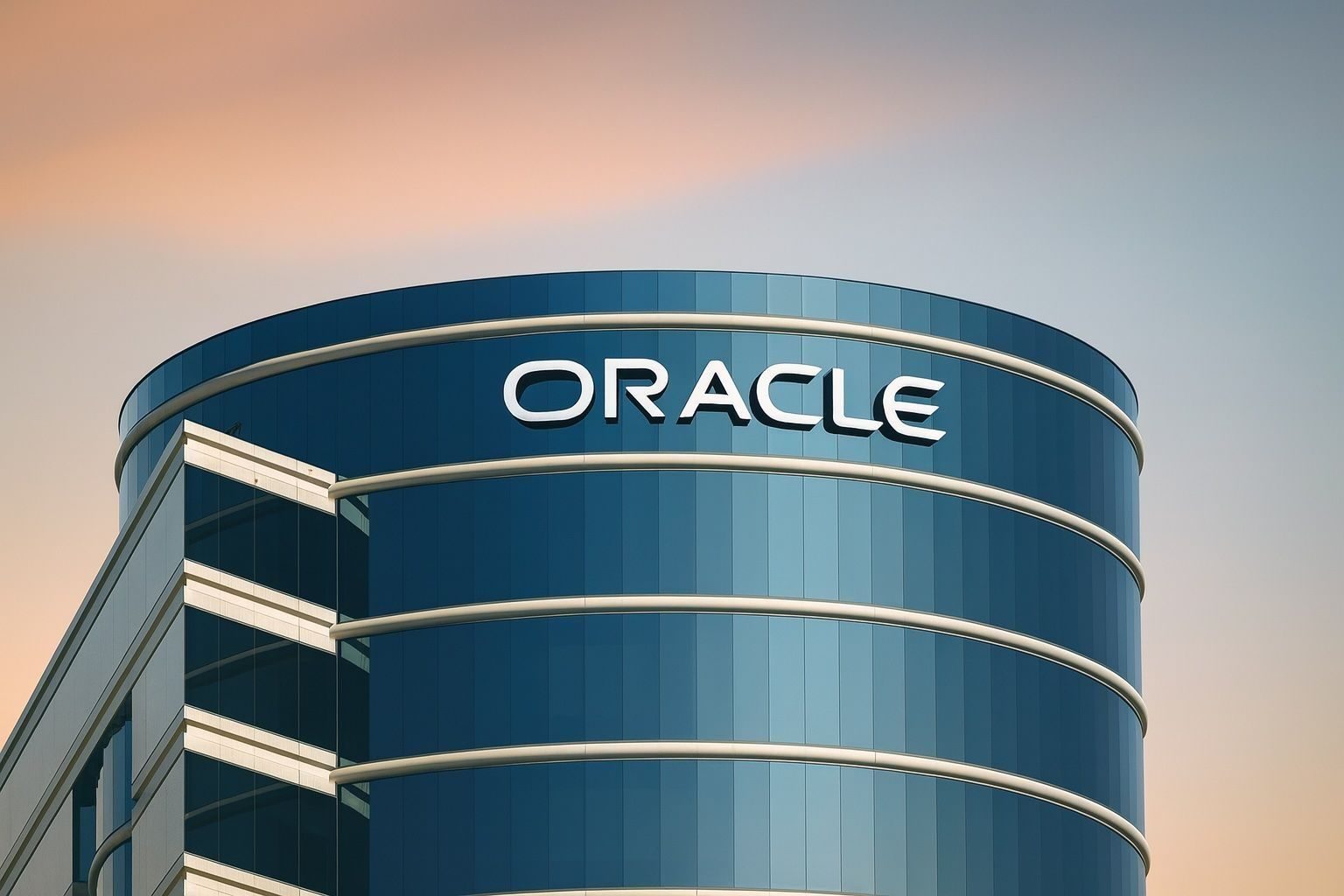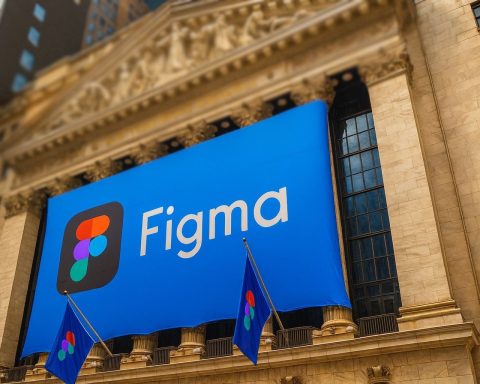Oracle Corporation (NYSE: ORCL) is back in the spotlight on Friday, November 28, 2025, as investors digest fresh warnings about its rising debt load, reports of a new $38 billion loan package to fund OpenAI-related data centers, and confirmation that the stock is among November’s worst-performing big‑tech names. [1]
Below is a detailed look at Oracle’s share price today, the latest news, and what it all means ahead of the company’s next earnings report in December.
Oracle stock price today: trading just under $200 after a steep November slide
Oracle shares are hovering around the $200 mark in early U.S. trading on November 28. MarketWatch data show that the stock previously closed near $204.96, with pre‑market trading indicating a move lower to about $199.80, a drop of roughly 2.5%. [2]
On some trading platforms, Oracle has recently changed hands around $199–$203, implying a modest intraday decline and leaving the company with a market capitalization of roughly $580–585 billion. [3]
The bigger story, however, is the month‑to‑date performance:
- Oracle is down about 29% over the past month, according to major stock‑screening services. [4]
- The stock trades more than 40% below its 52‑week high near $345, even though it is still well above its 12‑month low around $115–120. [5]
This puts Oracle squarely in “fallen AI favorite” territory: a mega‑cap name that surged on artificial intelligence optimism earlier in the year and is now giving back a large chunk of those gains.
New research flags rising debt risk as AI expansion accelerates
The sharp November sell‑off has been driven less by earnings misses and more by credit and balance‑sheet worries.
A widely circulated note highlighted by GuruFocus and other outlets cites Morgan Stanley analysts, who warn that Oracle’s five‑year credit‑default swap (CDS) spreads – the cost of insuring its debt – climbed to around 1.25 percentage points in November, the highest level since 2022, and could rise further if the company doesn’t clarify its long‑term funding strategy. [6]
Key points from that analysis and related reporting:
- Oracle has issued roughly $18 billion in bonds recently to finance its artificial intelligence and cloud‑infrastructure build‑out. [7]
- The company is associated with large project finance loans tied to new data‑center construction, pushing overall borrowing sharply higher compared with traditional software peers. [8]
- Credit investors are responding by hedging more aggressively, which is pushing CDS prices – and perceived default risk – higher. [9]
A separate deep‑dive from The Economic Times notes that Oracle’s free cash flow has recently swung negative, estimated around –$5.9 billion, as spending on AI data centers and related infrastructure surged. The article also points to a debt‑to‑equity ratio well above industry norms and a rapidly rising bill for servicing that debt – all of which have contributed to the roughly 30% share‑price drop over the last month. [10]
Debt, in other words, has become part of the story, not just background noise.
$38 billion loan talks for OpenAI data‑center build‑out
Debt concerns are being amplified by fresh headlines on November 28 about new funding tied to OpenAI.
Multiple outlets, including Yahoo Finance and GuruFocus, report that Oracle is in preliminary discussions with several banks about a loan package of roughly $38 billion. The money would help finance additional U.S. data‑center sites dedicated to hosting OpenAI workloads, according to a Financial Times report referenced in these stories. [11]
This potential loan comes on top of previously reported borrowing linked to Oracle’s AI expansion:
- Data‑center developers have reportedly borrowed tens of billions of dollars this year, with some financing tied directly to Oracle’s AI infrastructure ambitions and its massive multi‑year cloud agreement with OpenAI. [12]
- Articles covering the so‑called “Stargate” AI data‑center initiative describe an eye‑popping multi‑hundred‑billion‑dollar capital plan spread over several years, with Oracle as one of the central infrastructure partners. [13]
The $38 billion loan talks reinforce two competing narratives:
- Bullish view: Oracle is cementing its position as a core AI infrastructure provider, locking in long‑duration workloads from OpenAI and other hyperscalers. These obligations could support years of high‑margin cloud revenue if utilization ramps as expected. [14]
- Bearish view: The scale and speed of borrowing raise the risk that cash flows lag capex, forcing Oracle to rely heavily on debt markets while margins remain under pressure. If AI demand or pricing disappoints, the balance‑sheet strain could become more problematic. [15]
For now, the market seems focused more on the second narrative, which helps explain why today’s loan headlines have not led to a relief rally.
Among November’s worst‑performing big‑tech stocks
Oracle’s slide isn’t happening in isolation.
A new MarketWatch/Dow Jones report published on November 28 lists Oracle and Super Micro Computer among the worst‑performing technology stocks in November, as the once red‑hot AI trade cools and high‑flyer valuations reset. The piece notes that some large AI‑linked tech names have suffered month‑to‑date declines of up to 37%. [16]
Screening data back that up in Oracle’s case:
- Oracle’s one‑month performance is roughly –29%, placing it firmly in the laggard camp among mega‑cap tech names. [17]
- Over the past year, however, the stock is still well above its lows, reflecting how strong the earlier AI‑driven rally was. [18]
In other words, November has been a sharp re‑rating, not the collapse of a structurally broken business. The stock is moving from “priced for perfection” toward more contested territory where bulls and bears both have arguments.
The AI cloud story that still attracts believers
Despite the recent turbulence, a steady stream of research notes and long‑form analyses continue to pitch Oracle as a foundational AI and cloud‑infrastructure play.
Recent coverage highlighting Oracle’s AI positioning
- An analysis syndicated via Insider Monkey framed Oracle as one of the AI stocks analysts are actively betting on, noting that firms such as HSBC recently reiterated a “Buy” rating on the stock. [19]
- Another feature on Yahoo Finance underscored Oracle Cloud Infrastructure’s (OCI) role in the AI ecosystem, emphasizing its ability to host large AI workloads and collaborate with GPU leaders like Nvidia. [20]
At the company level, Oracle’s own financial and product disclosures support the AI‑heavy narrative:
- In its fiscal 2026 first‑quarter results (reported September 9, 2025), Oracle posted $14.9 billion in revenue, up 12% year‑over‑year, with cloud revenues up 28% to $7.2 billion. [21]
- The company reported an extraordinary 359% year‑over‑year jump in Remaining Performance Obligations (RPO) to around $455 billion, signaling a huge backlog of signed but not yet recognized revenue – much of it tied to cloud and AI workloads. [22]
- At Oracle AI World and in later interviews, management has articulated a long‑term target of roughly $225 billion in annual revenue by 2030, with about $166 billion expected from cloud infrastructure alone. [23]
Oracle is also rolling out more specialized infrastructure for sensitive AI workloads:
- A recent OCI announcement introduced “Dedicated Region 25”, a compact on‑premises cloud stack that brings 200+ Oracle AI and cloud services directly into customer data centers, aimed at regulated and sovereign environments. [24]
These data points form the backbone of the bullish AI thesis: Oracle is spending heavily because it sees a decade‑long wave of AI compute and data demand, and it believes its backlog and partnerships will eventually justify both the capex and the debt.
Wall Street and institutional positioning: cautious headlines, still‑bullish targets
On the surface, the news flow this morning sounds grim – “debt risk,” “worst‑performing tech stock,” “loan talks” – but sell‑side price targets and institutional flows tell a more nuanced story.
Institutional investors: still adding exposure
A fresh MarketBeat summary of regulatory filings shows that Virtus Investment Advisers LLCboosted its Oracle holdings by about 15.5% in the second quarter, to just over 10,000 shares, making ORCL its largest single portfolio position at roughly 0.7% of assets. [25]
The same report notes that large institutions – including Norges Bank and multiple U.S. wealth managers – have either established or expanded positions in Oracle over recent quarters, contributing to institutional ownership of more than 40% of outstanding shares. [26]
Analyst ratings and targets
According to aggregated data cited by MarketBeat and Finviz:
- Oracle carries a “Moderate Buy” consensus rating, with dozens of analysts rating the stock “Buy” or “Strong Buy,” a smaller group at “Hold,” and only a handful at “Sell.” [27]
- Average 12‑month price targets cluster in the low‑to‑mid $300s, with MarketBeat citing a mean around $325 and some datasets pointing closer to $345. [28]
Not every commentator is upbeat. Some recent pieces have framed Oracle’s aggressive AI spending as a “margin call” on the business, arguing that investors underestimated how long it would take for AI infrastructure projects to turn into high‑margin profits. [29]
But other long‑form analyses – including a new article on Seeking Alpha published just hours ago – argue that Oracle can “sail through” its debt backlog, pointing to:
- Management guidance for Q2 fiscal 2026 revenue of roughly $16–$16.3 billion, implying 14–16% year‑over‑year growth.
- Expected cloud revenue growth in the mid‑30% range.
- Non‑GAAP EPS guidance of about $1.61–$1.65. [30]
The upshot: even after November’s drop, much of Wall Street still values Oracle as a high‑growth AI infrastructure company, not a mature, ex‑growth database vendor.
Key catalyst ahead: Q2 FY 2026 earnings on December 8
The next major event on Oracle’s calendar is its fiscal 2026 second‑quarter earnings report, scheduled for Monday, December 8, 2025, with a conference call planned that evening. [31]
Consensus expectations across Nasdaq, Yahoo Finance and other trackers cluster around:
- Earnings per share (EPS): approximately $1.63–$1.64. [32]
- Revenue: about $16.2 billion, up double digits year‑over‑year. [33]
Given the latest headlines, investors will be watching this call for three things in particular:
- Funding strategy and leverage
- More concrete detail on how Oracle plans to finance large AI data‑center projects, including the reported $38 billion loan package, without letting leverage ratios spiral. [34]
- Cloud margins and cash flow
- Updates on cloud gross margins, capex trajectory and free cash flow, given that recent negative FCF figures have been a major driver of credit‑market anxiety. [35]
- AI backlog and utilization
- Any incremental disclosure around OpenAI‑related workloads, multicloud partnerships, and RPO growth will influence how sustainable the AI demand story looks heading into 2026. [36]
A positive surprise on any of these fronts could help stabilize the stock after its November drawdown; a negative surprise could extend the current re‑pricing.
How today’s news frames ORCL for different types of investors
Nothing in this article is personalized financial advice, but the risk‑reward picture emerging from today’s news flow is fairly clear:
What the bears are focused on
- Leverage is rising quickly as Oracle layers new bond deals and potential multi‑tens‑of‑billions loan packages on top of existing obligations. [37]
- Free cash flow has deteriorated, turning negative as capex for AI data centers and infrastructure spikes. [38]
- Oracle is now one of November’s worst‑performing big‑tech names, suggesting that the market is no longer willing to grant it a “no‑questions‑asked” AI premium. [39]
What the bulls are focused on
- Oracle’s AI and cloud backlog is enormous, with RPO north of $450 billion and cloud revenues growing at high‑20s to mid‑30s percentage rates. [40]
- Management and several analysts still forecast strong double‑digit revenue growth, supported by AI workloads, sovereign cloud deals, and Oracle’s aggressive data‑center build‑out. [41]
- Despite the debt overhang, institutional investors and analysts’ price targets remain broadly constructive, with consensus still well above today’s ~$200 share price. [42]
For short‑term traders, today’s combination of negative headlines and upcoming catalysts likely means continued volatility into the December 8 earnings event.
For long‑term investors, the central question is whether Oracle’s aggressive AI infrastructure bet — and the debt it is taking on to fund it — ultimately produces the kind of durable, high‑margin cloud business that justifies both the leverage and the current valuation.
As always, anyone considering ORCL should weigh these factors against their own risk tolerance, time horizon, and portfolio mix, and consult a qualified financial professional before making investment decisions.
References
1. www.gurufocus.com, 2. www.marketwatch.com, 3. www.etoro.com, 4. finviz.com, 5. finviz.com, 6. www.gurufocus.com, 7. www.gurufocus.com, 8. m.economictimes.com, 9. www.gurufocus.com, 10. m.economictimes.com, 11. uk.finance.yahoo.com, 12. m.economictimes.com, 13. markets.chroniclejournal.com, 14. finance.yahoo.com, 15. www.gurufocus.com, 16. www.morningstar.com, 17. finviz.com, 18. finviz.com, 19. finviz.com, 20. finance.yahoo.com, 21. investor.oracle.com, 22. investor.oracle.com, 23. www.cloudcomputing-news.net, 24. www.oracle.com, 25. www.marketbeat.com, 26. www.marketbeat.com, 27. www.marketbeat.com, 28. www.marketbeat.com, 29. www.marketbeat.com, 30. seekingalpha.com, 31. finance.yahoo.com, 32. finance.yahoo.com, 33. www.marketbeat.com, 34. finance.yahoo.com, 35. m.economictimes.com, 36. investor.oracle.com, 37. www.gurufocus.com, 38. m.economictimes.com, 39. www.morningstar.com, 40. investor.oracle.com, 41. www.cloudcomputing-news.net, 42. www.marketbeat.com







